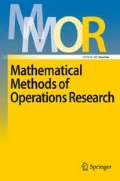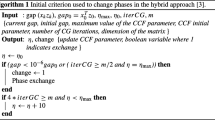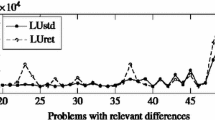Abstract
This study analyzes the influence of sparse matrix reordering on the solution of linear systems arising from interior point methods for linear programming. In particular, such linear systems are solved by the conjugate gradient method with a two-phase hybrid preconditioner that uses the controlled Cholesky factorization during the initial iterations and later adopts the splitting preconditioner. This approach yields satisfactory computational results for the solution of linear systems with symmetric positive-definite matrices. Three reordering heuristics are analyzed in this study: the reverse Cuthill–McKee heuristic, the Sloan algorithm, and the minimum degree heuristic. Through numerical experiments, it was observed that these heuristics can be advantageous in terms of accelerating the convergence of the conjugate gradient method and reducing the processing time.
Similar content being viewed by others
References
Andersen E, Gondzio J, Mészáros C, Xu X (1996) Implementation of interior point methods for large scale linear programming. In: Terlaky T (ed) Interior point methods in mathematical programming. Kluwer Academic Publishers, Dordrecht, pp 189–252
Benzi M (2002) Preconditioning techniques for large linear systems: a survey. J Comput Phys 182:418–477
Bocanegra S, Campos F, Oliveira A (2007) Using a hybrid preconditioner for solving large-scale linear systems arising from interior point methods. Comput Optim Appl 36:149–167
Campos F (1995) Analysis of conjugate gradients-type methods for solving linear equations. Ph.D. thesis, Oxford University Computing Laboratory
Chai J, Toh K (2007) Preconditioning and iterative solution of symmetric indefinite linear systems arising from interior point methods for linear programming. Comput Optim Appl 36:221–247
Cuthill E, McKee J (1969) Reducing the bandwidth of sparse symmetric matrices. In: Proceedings of the 24th National Conference ACM, pp 157–172
Czyzyk J, Mehrotra S, Wagner M, Wright S (1999) PCx an interior point code for linear programming. Optim Methods Softw 11(2):397–430
Duff I, Meurant G (1989) The effect of ordering on preconditioned conjugate gradients. BIT 29:635–657
George A (1971) Computer implementation of the finite element method. Ph.D. thesis, Department of Computer Science, Stanford University
George A (1973) Nested dissection of a regular finite element mesh. SIAM J Numer Anal 10(2):345–363
George A, Liu J (1980) A fast implementation of the minimum degree algorithm using quotient graphs. ACM Trans Math Softw 6(3):337–358
George A, Liu J (1981) Computer solution of large sparse positive definite systems. Prentice Hall, New Jersey
Gondzio J (1996) Multiple centrality corrections in a primal-dual method for linear programming. Comput Optim Appl 6:137–156
Hu Y, Scott J (2001) A mutilevel algorithm for wavefront reduction. SIAM J Sci Comput 23(4):1352–1375
Karmarkar N (1984) A new polynomial algorithm for linear programming. Combinatorica 4:373–395
Kumfert G, Pothen A (1997) Two improved algorithms for envelope and wave-front reduction. BIT Numer Math 37(3):559–590
Lustig I, Marsten R, Shanno D (1992) On implementing Mehrotra’s predictor-corrector interior point method for linear programming. SIAM J Optim 2:435–449
Mehrotra S (1992) On the implementation of a primal-dual interior point method. SIAM J Optim 2(4):575–601
Mészáros C (2013) On sparse matrix orderings in interior point methods. Optim Eng 14(4):519–527
Oliveira A (1997) A new class of preconditioners for large-scale linear systems from interior point methods for linear programming. Ph.D. thesis, Department of Computational and Applied Mathematics, Rice University
Oliveira A, Sorensen D (2005) A new class of preconditioners for large-scale linear systems from interior point methods for linear programming. Linear Algebra Appl 394:1–24
Resende M, Veiga G (1993) An efficient implementation of a network interior point method. DIMACS Ser Discrete Math Theor Comput Sci 12:299–348
Rothberg E, Hendrickson B (1998) Sparse matrix ordering methods for interior point linear programming. INFORMS J Comput 10:107–113
Sloan S (1986) An algorithm for profile and wavefront reduction of sparse matrices. Int J Numer Methods Eng 23:239–251
Sloan S (1989) A FORTRAN program for profile and wavefront reduction. Int J Numer Methods Eng 28:2651–2679
Velazco M, Oliveira A, Campos F (2010) A note on hybrid preconditioners for large-scale normal equations arising from interior point methods. Optim Methods Softw 25(2):321–332
Wright S (1997) Primal-dual interior-point methods. SIAM, Philadelphia
Yannakakis M (1981) Computing the minimum fill-in is NP-complete. SIAM J Algebraic Discrete Methods 2:77–79
Acknowledgements
The authors would like to thank the Foundation for the Support of Research of the State of São Paulo (FAPESP) and the Brazilian Council for the Development of Science and Technology (CNPq).
Author information
Authors and Affiliations
Corresponding author
Rights and permissions
About this article
Cite this article
Silva, D., Velazco, M. & Oliveira, A. Influence of matrix reordering on the performance of iterative methods for solving linear systems arising from interior point methods for linear programming. Math Meth Oper Res 85, 97–112 (2017). https://doi.org/10.1007/s00186-017-0571-7
Received:
Published:
Issue Date:
DOI: https://doi.org/10.1007/s00186-017-0571-7




